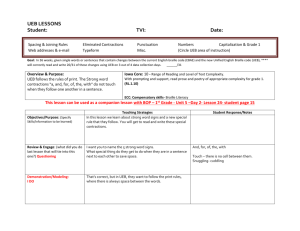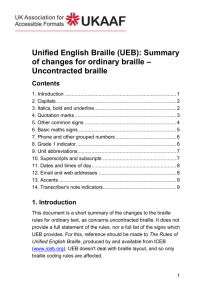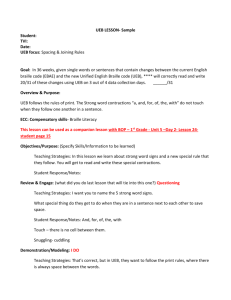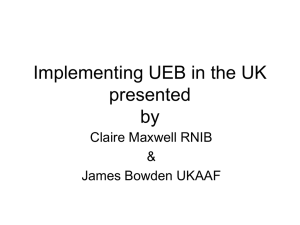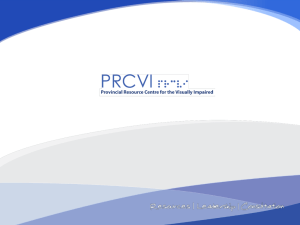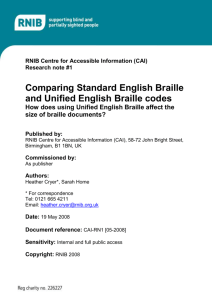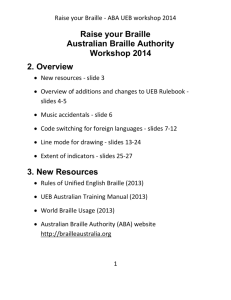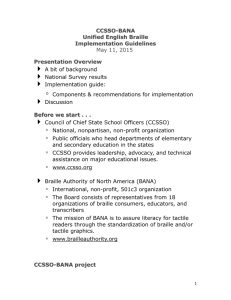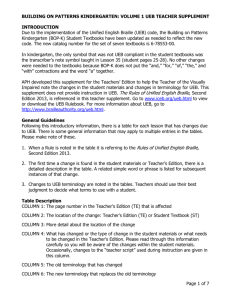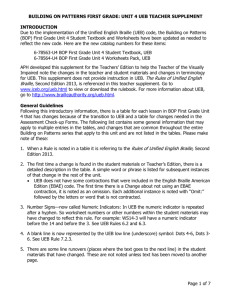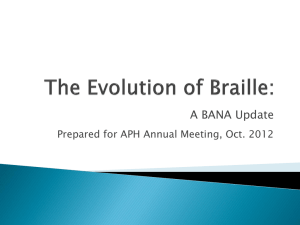Be All You Can UEB!
advertisement
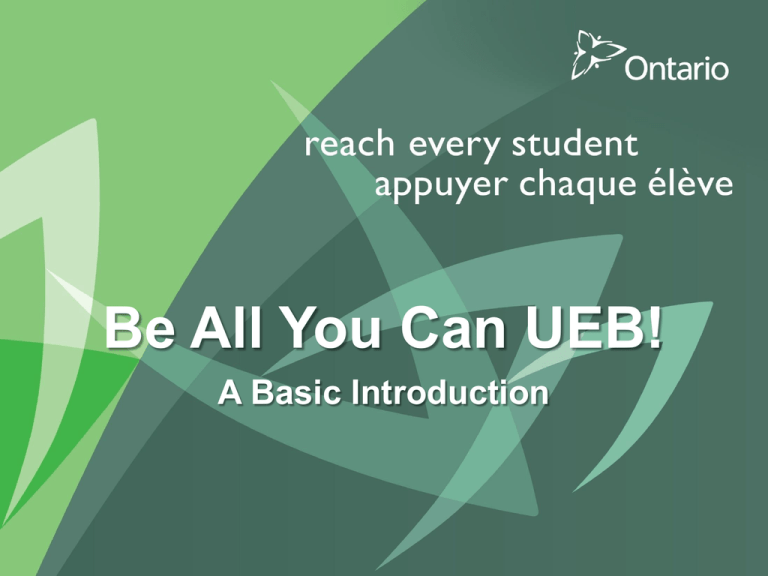
PUT TITLE HERE Be All You Can UEB! A Basic Introduction Introduction to UEB Nancy Sanders, Executive Director, Provincial Schools Branch Contractions • • • • No new contractions have been introduced in Unified English Braille (UEB) The following nine contractions in Standard English Braille (SEB) have not been included in UEB: ble com dd ally ation to into by o’clock These were eliminated to ensure one braille symbol is assigned one meaning. For example, the contraction “ble” could look like a number sign. Some rules that apply to the remaining 180 contractions, word-signs and short-forms have changed. Parameters around when and when not to use contractions have changed, and some contractions are used more often in UEB. Spacing • Spacing will follow the print. • Do not join words that were previously joined in SEB (and, for, of, with, a, the). UEB Prefixes • In UEB all braille characters are designated as either a prefix or a root. • There are eight prefixes: The numeric indicator plus the braille characters formed from the dots in the right column of the cell. The UEB prefixes are: • Examples of these prefixes will be shown on the following pages. Changed Punctuation and Other Symbols • The following are examples of punctuation and symbols using a prefix and a root. New Symbols • Here are some examples of symbols that were not available in SEB (note the prefix and root formation of these symbols). A dot is a dot is a dot! • Wherever a dot that resembles a period appears in print, dots 2-5-6 are used to represent the dot. Capitalization • Single dot 6 means that the next letter is capitalized (same as SEB) Canada • Double dot 6 means that the next word, or string of letters, is capitalized (same as SEB) CANADA *New* • Triple dot 6 means that the next passage (3 or more words) is capitalized. To show the end of the passage, dot 6 dot 3, is used; this is called a capitalization terminator. CANADA, OUR HOME AND NATIVE LAND Grade 1 Indicator • In SEB, dot 5-6 is known as the letter sign. • In UEB, dot 5-6 is called the Grade 1 Indicator, and is an integral part of the literary and math code. • A braille symbol may have an uncontracted, contracted or numeric meaning. A grade 1 indicator is used to set grade 1 mode when the grade 1 meaning of a symbol could be misread as a contraction or a numeric meaning. Grade 1 Indicator - Literacy • A single Grade 1 indicator [dot 5-6] means that the next symbol is in grade 1. j • A double Grade 1 indicator [dot 5-6, 5-6] means that the next word is in grade 1. g -g- g- go • A triple Grade 1 indicator [dot 5-6, 5-6, 5-6] means that the next passage (three or more words) is in grade 1. To show the end of the passage, dot 5-6 dot 3, is used; this is called a grade 1 terminator. I w-ll l-ve y-u f-r-v-r! A number is a number is a number! • In the full adoption of UEB, Canada, similar to Australia, New Zealand, South Africa, Nigeria and the UK, have replaced Nemeth Code with UEB • All numbers will be represented by the following: Operation Signs • The following are the basic operation signs for: Grade 1 Indicator - Math • Grade 1 indicators will not be needed for simple arithmetic problems involving numbers, operation signs, numerical fractions and mixed numbers. 3-2 = 1 • As previously stated, a braille symbol may have an uncontracted, contracted or numeric meaning. A grade 1 indicator is used to set grade 1 mode when the grade 1 meaning of a symbol could be misread as a contraction. • Simple algebraic equations which include letters may need grade 1 symbol indicators where letters stand alone or follow numbers. y = x+4c Reflections • UEB implementation in other countries has been a gradual process, but has occurred more quickly than anticipated in most cases • UEB outcomes for braille readers have been positive with increased ease of reading and less ambiguity Access to UEB Materials Where will UEB materials be obtained? • Alternative Education Resources for Ontario (AERO) has a pivotal role in the production of UEB materials during the transition from SEB to UEB • The Canadian National Institute for the Blind (CNIB) announced that all new requests for braille material will be produced in UEB as of April, 2013 Where Do You Fit In? As professionals in the field of vision we will all take a leadership role in the implementation of UEB. This is an exciting time of change and will be most exciting for our students! UEB In Action! The following is a video clip of a grade 10 student reading a UEB text passage for the first time. Differences in the UEB code are acknowledged and explained by the teacher throughout the video clip. There are 13 differences in the UEB passage as compared to the same passage in SEB and yet, the student is able to read the passage without difficulty. After being introduced to new symbols once, she is able to decipher them the second time without assistance. UEB In Action! UEB Trainers
